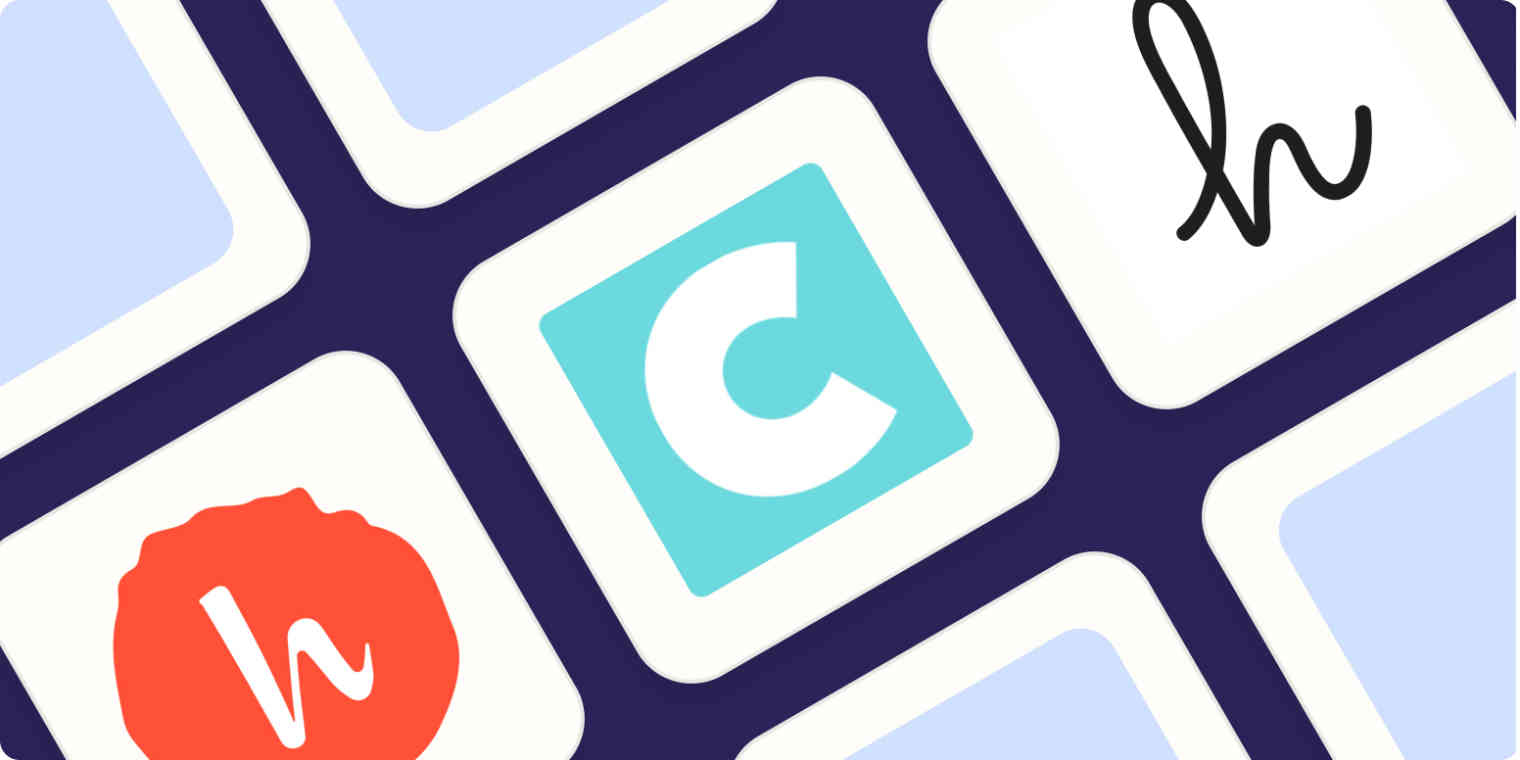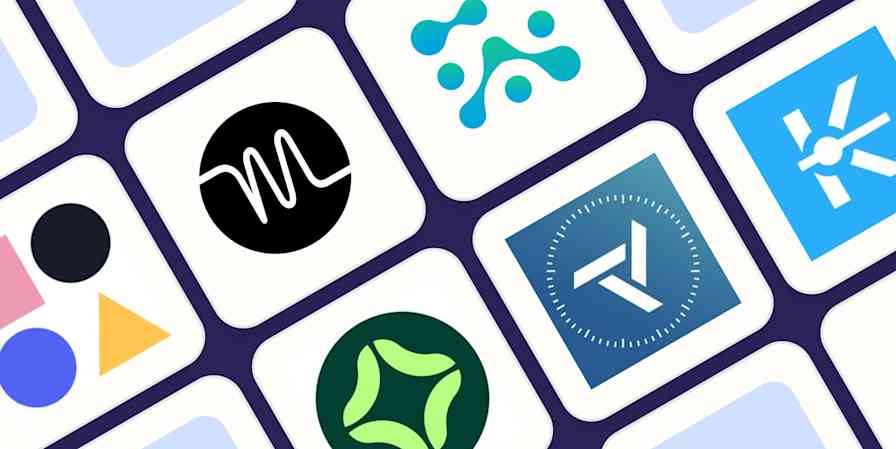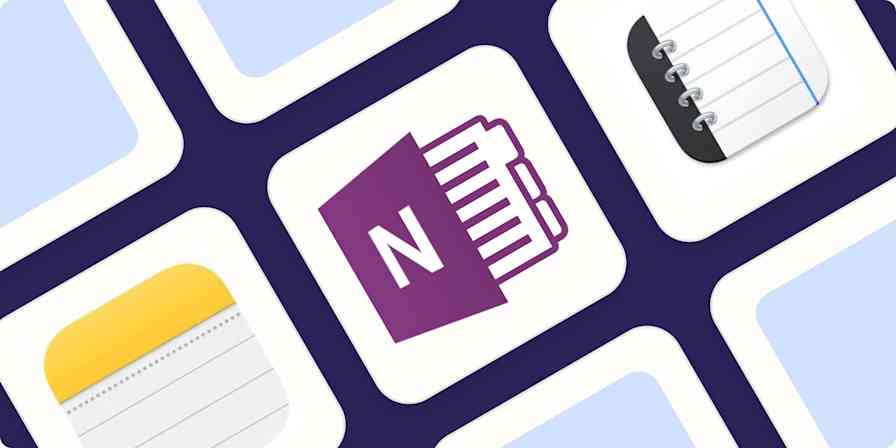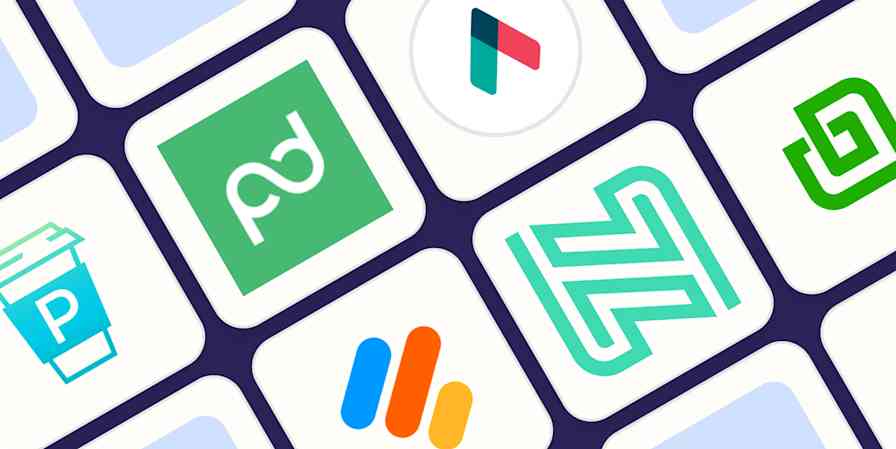There's one new-to-the-scene food delivery app I find myself repeatedly going back to and recommending to friends. It's not because they offer the best prices or the biggest selection of food options—I'd go to the more established apps for that. Instead, it's because every meal comes with a handwritten "thank you" note.
While the gesture might seem small, these notes, which are written by the chef who cooked my meal, go a long way in terms of gaining my loyalty—and my money.
Regardless of the industry you work in or the size of your business, sending a "thank you" card to your customers can have a similar effect. It's a great lead management tool, and there are plenty of apps that allow you to do this at scale.
For this article, I considered over 25 apps for creating and mailing greeting cards to find the best in the business. After extensive testing, here are the ones that came out on top.
Note: While many of these apps can also be used to send more personal cards that you'd reserve for family and friends (e.g., wedding invitations and birthday cards), the focus of this article is using these apps as a customer marketing tool.
The 5 best apps for creating and mailing greeting cards
Handwrytten for sending cards that look like they were personally handwritten
Cardly for the best selection of gift card add-ons
Postable for collecting your customers' mailing information with their consent
Handwrite for mailing greeting cards to customers based in the U.S.
Thanks for writing messages in multiple languages
What makes a great app for creating and mailing greeting cards?
How we evaluate and test apps
Our best apps roundups are written by humans who've spent much of their careers using, testing, and writing about software. Unless explicitly stated, we spend dozens of hours researching and testing apps, using each app as it's intended to be used and evaluating it against the criteria we set for the category. We're never paid for placement in our articles from any app or for links to any site—we value the trust readers put in us to offer authentic evaluations of the categories and apps we review. For more details on our process, read the full rundown of how we select apps to feature on the Zapier blog.
You have enough lead management tasks to deal with as it is, so a key element of the best app for creating and mailing cards is convenience. From picking a card to adding a recipient, the overall process needs to be faster than doing it manually.
Along with convenience, the best apps for thanking your customers via snail mail must include the following:
Ease of use. This isn't rocket science. The process of designing a card, writing a message, and getting it in the mail should be straightforward and clear.
Contact management. Because you'll likely send more than one card throughout your business's lifetime, it needs to be quick and easy to add your existing list of contacts along with new ones.
Card selection. More isn't necessarily better when it comes to card selection (who has the time to slog through too many choices?), but when choosing a greeting card app, you want to be sure it offers the right options for your needs.
Customization. How much can you customize to make the card look like you personally went to the store, picked the card, wrote a message, and popped it in the mailbox? Can you upload your own card design? What about the writing fonts? Can you store message templates to save yourself from having to write the same message over and over again?
Cost. Premium services come with a premium price tag, and that's fine. But pricing ultimately needs to be clear and match the value you get. For example, one greeting card app included too many variables that would impact the final price per card, so I cut it from the list.
To test each app, I created an account, explored all the available features, and customized my own card. For each card, I uploaded my own design or chose a pre-made one with lots of rich colors to see the quality of the ink in the final product. When it came to adding in recipients, I tested two main methods of adding contacts to the app wherever possible: using the provided template and uploading my own spreadsheet followed by data mapping. Then I waited very patiently (read: I wasn't patient at all) for my many cards to arrive in the mail.
Note: To simplify the numbers and make it easier to compare the costs, the pricing mentioned below reflects what you can expect to pay for a single card.
The best greeting card app for sending cards that look like they were personally handwritten
Handwrytten

Handwrytten checks all the boxes with just enough bells and whistles to get the job done. Its sleek interface makes it easy to sort through the pre-made card designs. Alternatively, you can upload your own branded design.
You can also write messages with merge fields and save them as templates for future use. While there are only three available merge fields (first name, last name, and business name), these will still go a long way in automatically giving your card a personal touch.
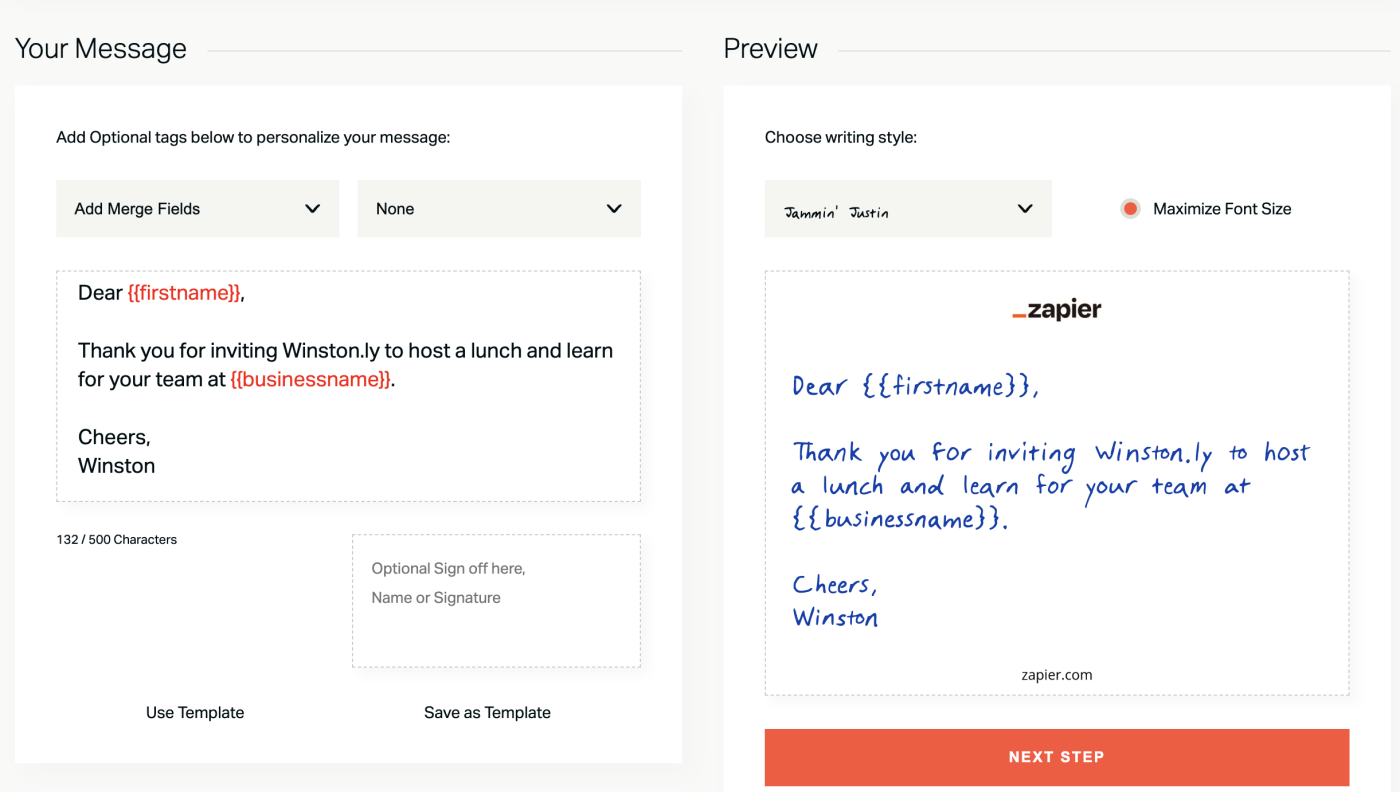
Speaking of messages, there's a limit of 500 characters, but that should be more than enough to get your message across. I bring this up because the character limit quickly became a source of frustration for me when testing out other apps.
And if the above isn't enough, here are three features unique to Handwrytten that make this app my top pick overall:
AI-powered writing assistant: While I was testing this app, they released an exciting new feature: an AI copywriting assistant named AI Assist. If you're familiar with other AI tools like ChatGPT and Notion AI, AI Assist operates pretty well the same. Simply type in a brief prompt, and AI Assist will populate a message for you. Whether you're drawing a blank on what to write, or you can't afford to add yet another task to your to-do list, AI Assist is an incredibly useful feature—at no extra cost.
Custom handwriting fonts: Handwrytten offers 32 handwriting fonts to choose from. Combine this with the robots they use to write the message while holding real ink pens, and you get cards that look like they were actually written by a human—tiny smudges and all. For an added fee, you can also add a custom signature or create your own handwriting font.
Real-time message preview: Unlike other apps that let you preview the final message only after you've written it, Handwrytten gives you a real-time preview, so you can minimize the back-and-forth of editing. Plus, the text size automatically adjusts to the length of your message, making it one less thing you have to format.
There's one other interesting feature: for U.S. recipients, you can include gift cards to popular retailers, including Target, Starbucks, and Amazon. However, there's a steep convenience fee of $4.95 per card. This means that a $25 Starbucks gift card, for example, will actually cost you $29.95. If you're looking for gift card add-ons, Cardly, which is part of this list, might be a better fit.
Handwrytten even integrates with Zapier, so you can do things like automatically send a thank you card when a certain action occurs in your go-to apps.
Send Handwrytten welcome notes to new WooCommerce customers
My only gripe with Handwrytten is that you have to use their provided template to upload multiple contacts at once. You can't upload your own spreadsheet containing your customers' mailing details, which most other apps allow you to do. That being said, it's easy enough to copy and paste data from your spreadsheet into Handwrytten's template.
Finally, it's worth noting that if you're using Handwrytten to give the impression that you personally mailed the card, the stamp on the envelope is going to blow your cover. That is, unless your business is based in Phoenix, Arizona, which is where all cards are processed.
Handwrytten price: Most individual cards start at $3.75, not including postage. Subscription plans start at $99/month, which includes a set number of card credits per month and domestic postage within the U.S. Any unused credits can be rolled over into the next month.
The best greeting card app for the best selection of gift card add-ons
Cardly
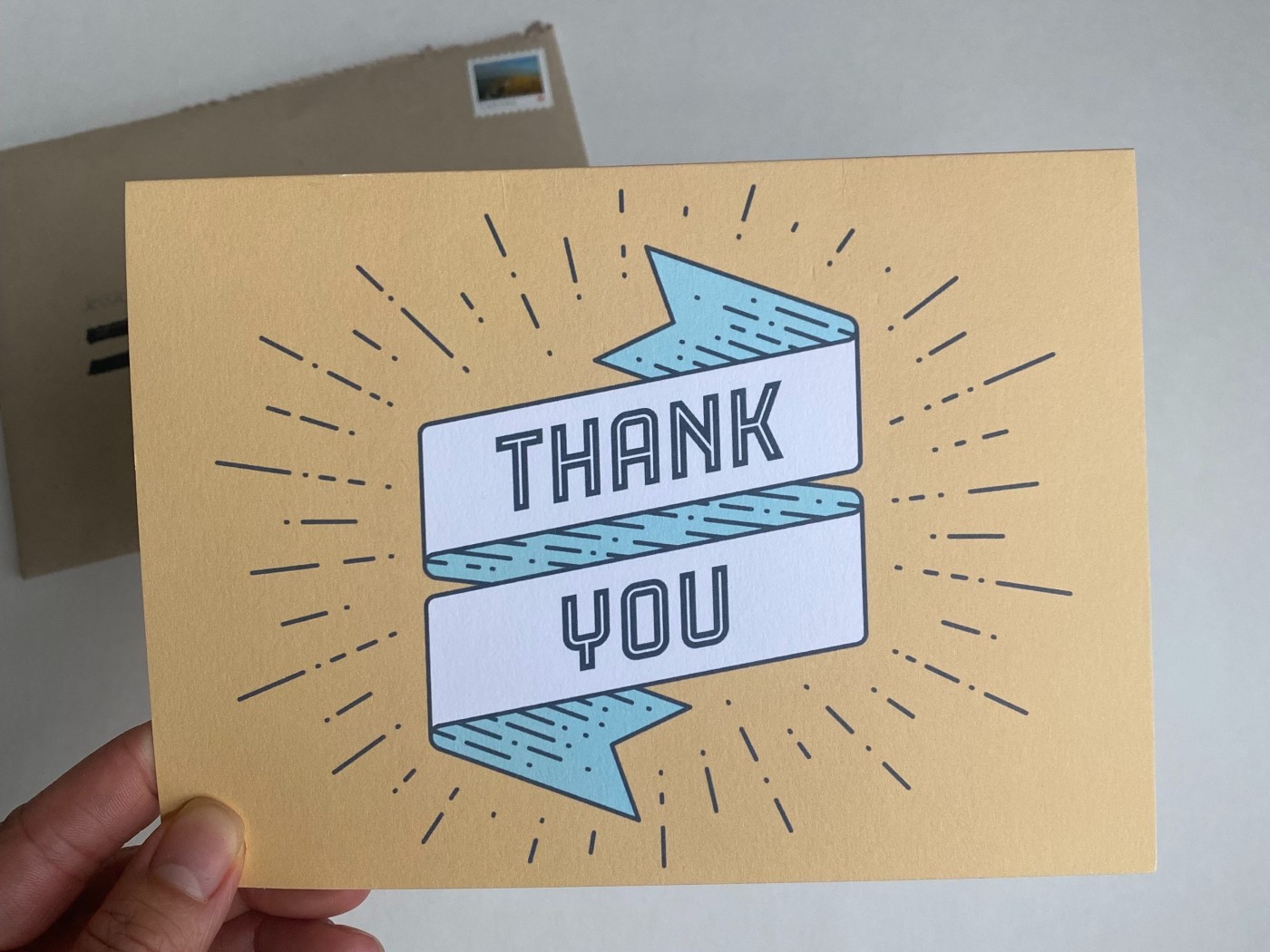
If you, like me, get overwhelmed by too many choices, then Cardly is not the app for you. But if you can navigate an inexplicable amount of choice—everything from card design to formatting tools—read on.
To build a card in Cardly, you can upload your own design or choose from a robust selection of stock designs and premium artist designs. If you go with the former, the process is fairly straightforward. If you go with the latter, here's my advice: only use the search bar to narrow down the card options. Otherwise, you might find yourself filtering through cards based on its color or "vibe," which is to say you probably won't find what you're looking for.

If you're able to get to the other side of picking a card, Cardly does have truly some standout features:
Gift card add-ons: Unlike other apps in this list, you can include gift cards to recipients in the U.S., Canada, Australia, and the U.K. (the most number of regions for any greeting card app)—for free. If you're sending a lot of gift cards, the convenience and savings here can be really compelling.
Customized handwriting font: If you send over 200 cards, you can create your own handwriting font, again, for free. However, it's worth mentioning that the final message will still look like it was printed by a computer and not written by you, so I'm not convinced there's any real value in creating your own font.
Quality: While most of the cards I received when testing different greeting card apps were of good quality, my Cardly card took home the prize for best quality. I genuinely felt compelled to display it in my home office because it looked like a card a friend would send.
Cardly even makes it easy to upload your own spreadsheet to quickly populate your address book. But a word of caution: the app won't flag if any of the addresses are undeliverable. But you can integrate Cardly with Zapier to automatically sync your contacts from another app, such as HubSpot, reducing the risk of manually inputting incorrect data.
Send welcome cards with Cardly for new BrokerEngine contacts
Cardly price: Individual cards using your own design or complimentary artwork (i.e., stock images) technically start at $4.95, including postage. However, cards with complimentary artwork were few and far between. I clicked through over 15 of these designs, yet they were just as expensive as premium designs—a whopping $7.95 per card.
If you're on a business plan, you save a few dollars per card. But unless you plan to send more than 500 cards, you can still expect to pay upwards of $4.50 per card.
The best greeting card app for collecting your customers' mailing information
Postable

Postable's homepage does a really nice job of clearly communicating exactly what it does: "really nice cards mailed for you." Much like the other apps that made this list, Postable is incredibly easy to use for creating and mailing cards.

In addition to this, here are the other features that made it shine:
Robust selection of pre-made designs. While other apps in this list include business-appropriate pre-made designs, Postable takes the cake for offering the most options with a stunning variety of modern designs. And it's easy to filter through the options by card format (folded, flat, or postcard), orientation, and cards with or without a space for photos. The last filter is great if you want to include a photo of your team for, say, a holiday card.
Scheduled deliveries. By default, Postable ships your cards within one to two business days. If you want to schedule a delivery, you have the option to delay the send so that it arrives by a certain date. Of course, they can't guarantee it'll arrive exactly on the specified date, especially if the card is being sent outside of the U.S.
Postable address book. The Postable address book helps you collect your customers' mailing addresses—with their consent, of course. And the service is free. However, the process is a mix of manual and automated.
Here's how the address book part works: In Postable, you can customize a templated address request form. This includes the welcome message at the top of the form and the information you want to ask for (name, mailing address, birthday, etc.) Then Postable provides you with a unique link to the form, which you can then send to your customers to fill in.
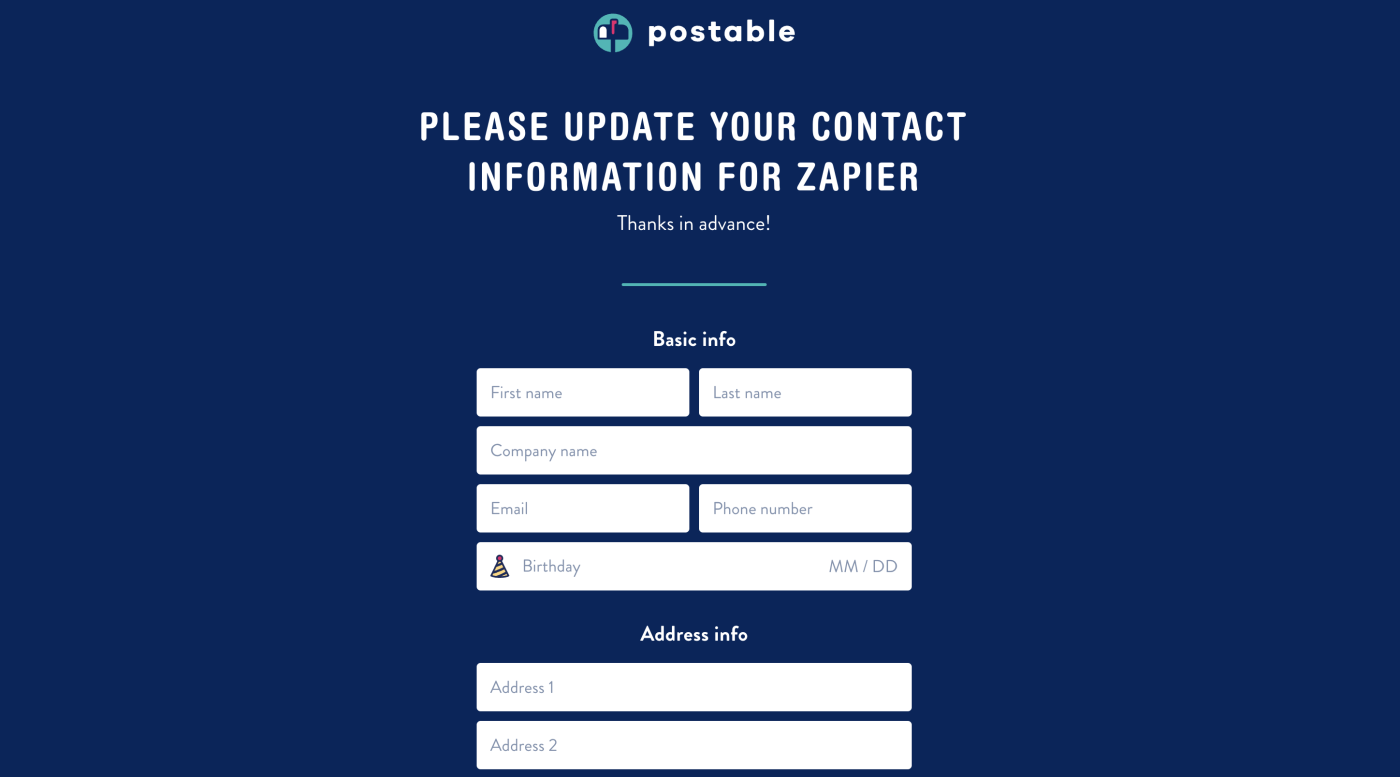
When you send the link, I'd suggest letting them know why you're collecting their information to increase the chance of them responding. For example, you might want to be honest and say, "We'd like to send you a note to express our gratitude." Once your customer completes the form, that data is automatically stored in your Postable address book for future use. And if you already have your customers' mailing information, Postable makes it easy to upload your existing spreadsheet and map their data.
There were a few drawbacks to using Postable. For example, the data mapping in my address book wasn't always accurate. Additionally, it took over three weeks for my card to arrive in Canada, which was really long compared to other apps.
Postable price: Individual cards are $3.99 each, not including postage. While they don't provide subscription plans, you can buy credits to get each card at a lower price without having to do a bulk order.
The best greeting card app for mailing greeting cards to customers based in the U.S.
Handwrite
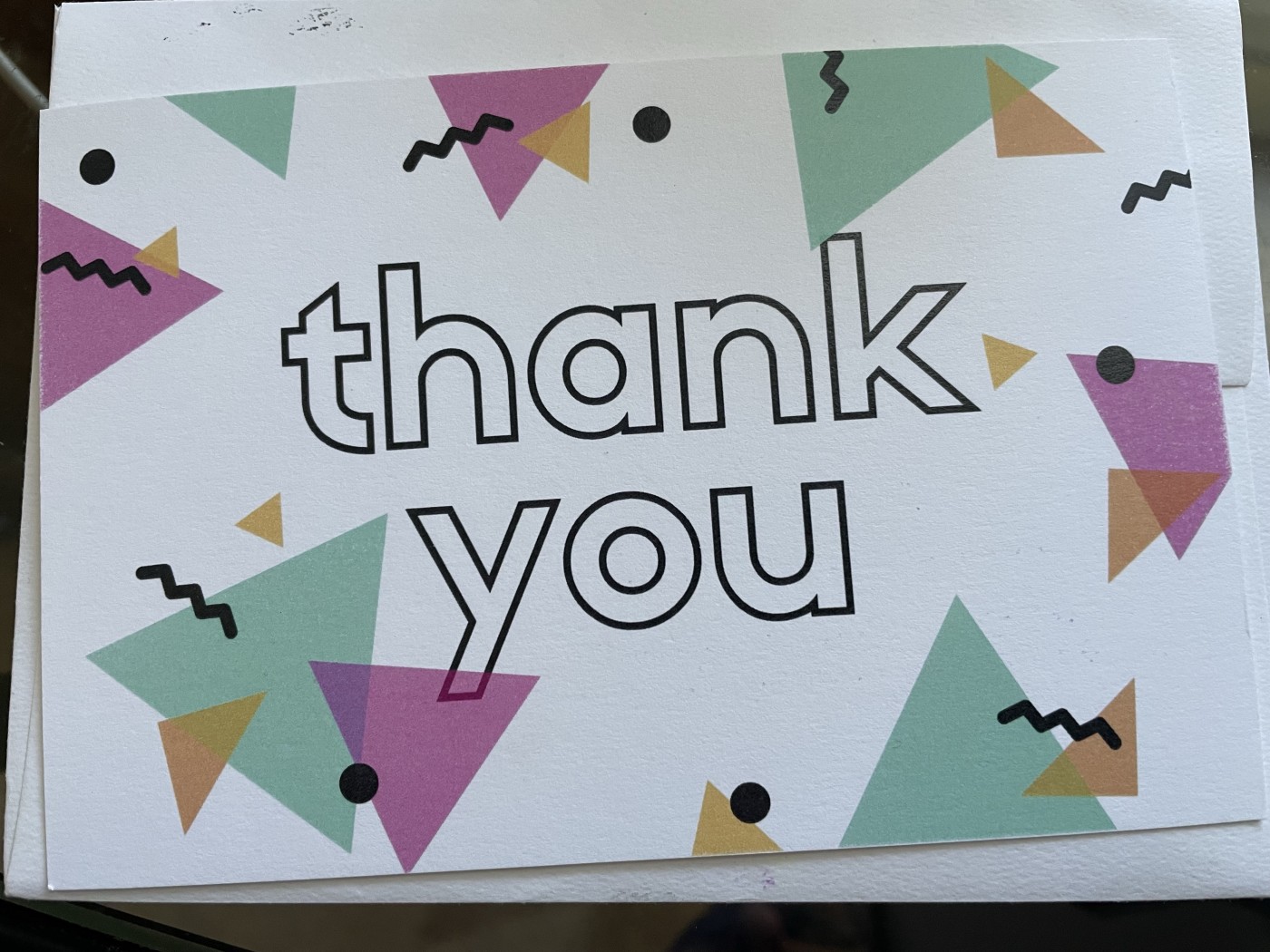
If you're looking for a budget-friendly app for creating greeting cards and mailing them to customers in the U.S., Handwrite might be the app for you.
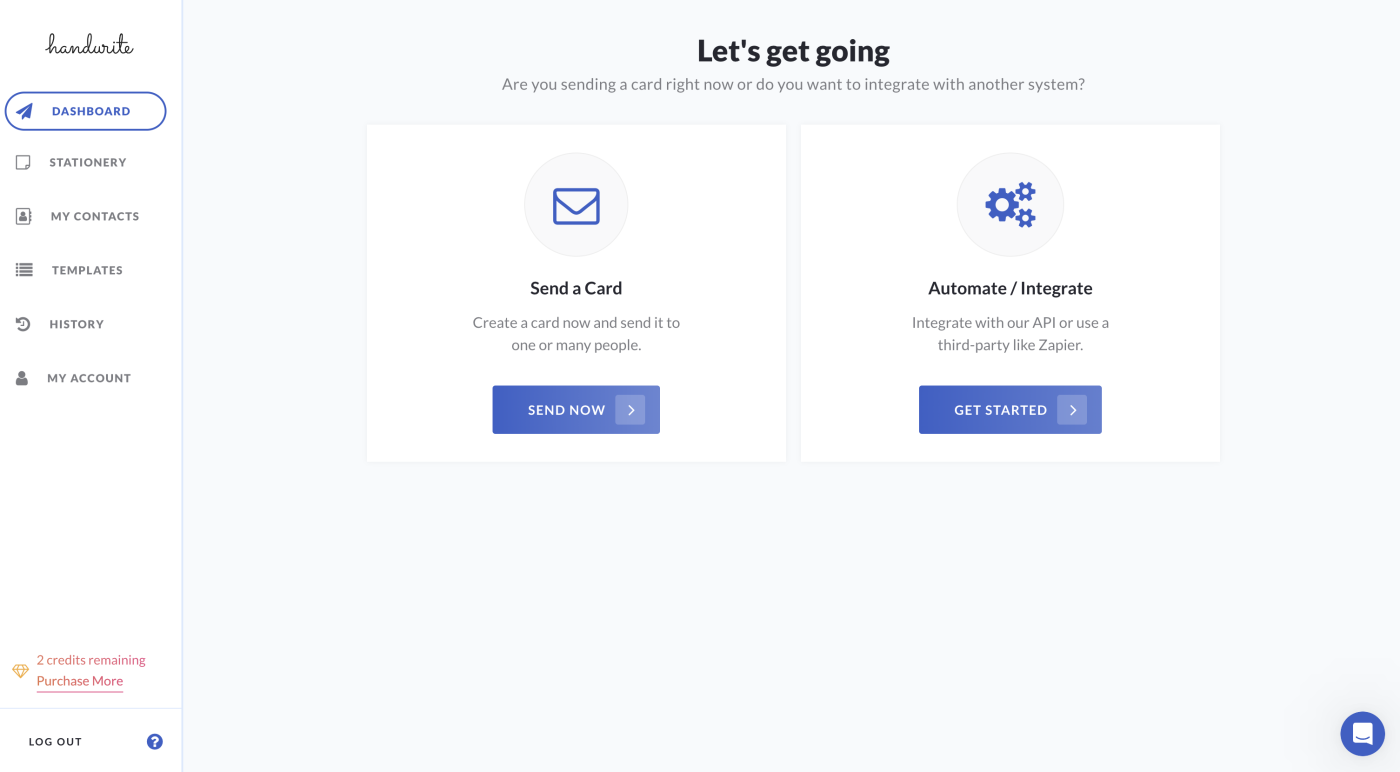
The entire process—from picking a card to uploading your contact list—is simple and clear. In addition to that, here are a few standout features of the app:
Handwritten messages, sort of. There are seven handwriting fonts to choose from. But to make it look truly convincing, Handwrite uses robots holding ink pens to write your message. The only other app in this list that offers this nifty technology is Handwrytten.
Frequency alerts. Before you confirm a card delivery, Handwrite will let you know if you previously sent a card to the same recipient within the last month. Consider it Handwrite's way of helping you strike the right balance of being in your customer's mailbox without inundating their mailbox.
Message templates. Handwrite lets you save message templates, preventing you from having to write similar messages over and over again. Unfortunately, they don't have merge fields, so you'll have to manually update details like your customer's name or business name.
While the positives of Handwrite are appealing, there are a few bugs worth mentioning. For example, there isn't a great assortment of business-appropriate options. And if you upload your own design, the formatting gets a little wonky. Another drawback is that it only gives you six lines to write your message. With a traditional greeting ("Dear [insert name]") and complimentary close ("Cheers" plus your name across two lines), that's already three lines. This doesn't leave much room to write a thoughtful message which is the whole point of sending a greeting card.
And despite trimming my message to fit the character and limits, this is what came in the mail:
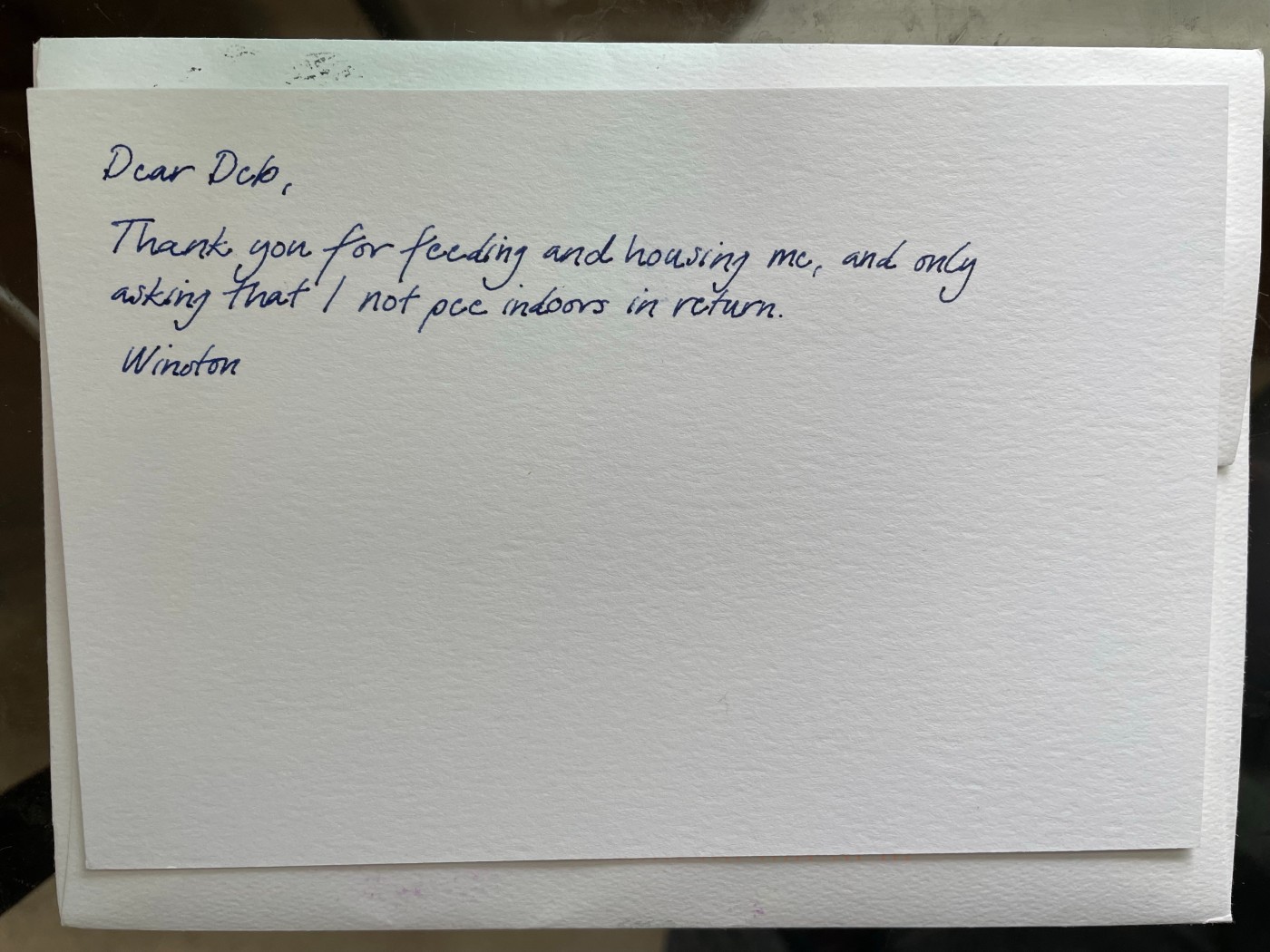
Look at all that space! For the record, this is not what the message preview looked like when I drafted it.
Handwrite also integrates with Zapier, so you can do things like automatically send a handwritten card when a new record is entered in Shopify or Google Sheets.
Handwrite price: Individual cards cost $2.99, including postage.
The best greeting card app for writing messages in multiple languages

Thanks is the only greeting card app I tested that offered handwriting fonts in seven other languages: Arabic, simplified Chinese, Cyrilic, Hebrew, Japanese, Korean, and Vietnamese. In my opinion, this is the only worthwhile feature that sets Thanks apart from the rest of the apps listed in this article.
Tip: Need to translate your client communications in other apps like Zendesk and Gmail? Try these Zapier templates, so you can automatically translate other languages and respond to clients faster.
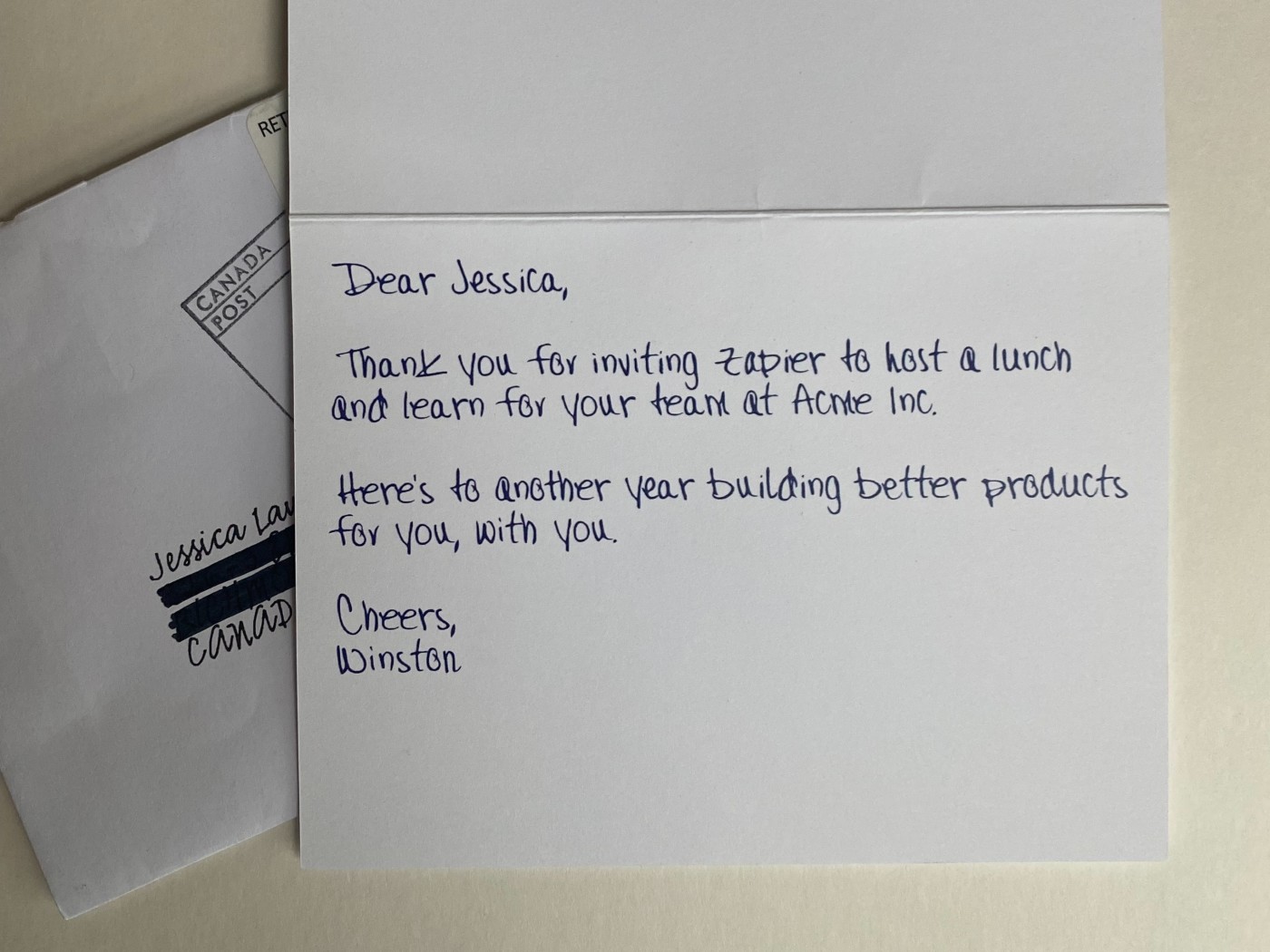
The app offers a few other unique features—but each comes with a potential drawback.
Gift card add-ons: For U.S. recipients, you can include a non-physical gift card with your greeting card. There are 60 gift cards to choose from, so you'll likely find something that suits every type of client. And if you're on a business plan, payments for gift cards are automatically deferred, which means you'll only be charged for the gift card after a client redeems it. However, if you're sending a lot of gift cards, the unpredictableness of this might make for an accounting nightmare. Additionally, Thanks' website doesn't make it clear if there's a convenience fee for this option.
Handwriting fonts: There are 12 English language fonts to choose from, which are meant to look personally handwritten. The card I received had a neatly printed message, but it was clearly done by a computer.
Card design options: Thanks offers 10 pre-made "thank you" card designs, but as you can tell in the GIF above, these designs leave much to be desired—especially if you're going for a more professional look. But you can customize the card by uploading your own design or creating a design online using Canva. You can even hire the Thanks team to design your card for you. Depending on your schedule and budget, these options may or may not be right for you.
Thanks also integrates with Zapier directly, so you can do things like automatically add customers to your recipient list and send templated cards.
Send Thanks.io postcards to new Salesforce contacts
Add new paid Shopify orders to Thanks.io as recipients
Thanks price: Individual notecards mailed within the U.S. cost $2.84, including postage. For deliveries outside of the U.S., each card is $4.04, including postage. They also offer a business plan for $49/month, which allows you to create and send cards for about $1.00 less than if you're not on a plan.
Build on your customer nurture: send a postcard
Sending greeting cards isn't the only way to keep your customers engaged. If your snail mail doesn't include a sensitive message, you could also send a postcard for things like appointment reminders and seasonal promotions. Postable and Thanks (listed above) are great ways to accomplish this.
But if all you want to do is send postcards to your customers, Stannp is also a great option. Bonus: Stannp integrates with Zapier, so you can automatically send postcards (and letters) to your customers. Here are a few templates to get you started.
Send Stannps letters to the recipients of new WooCommerce orders
Related reading
This article was originally published in November 2018 by Jill Duffy. The most recent update was in April 2023.
